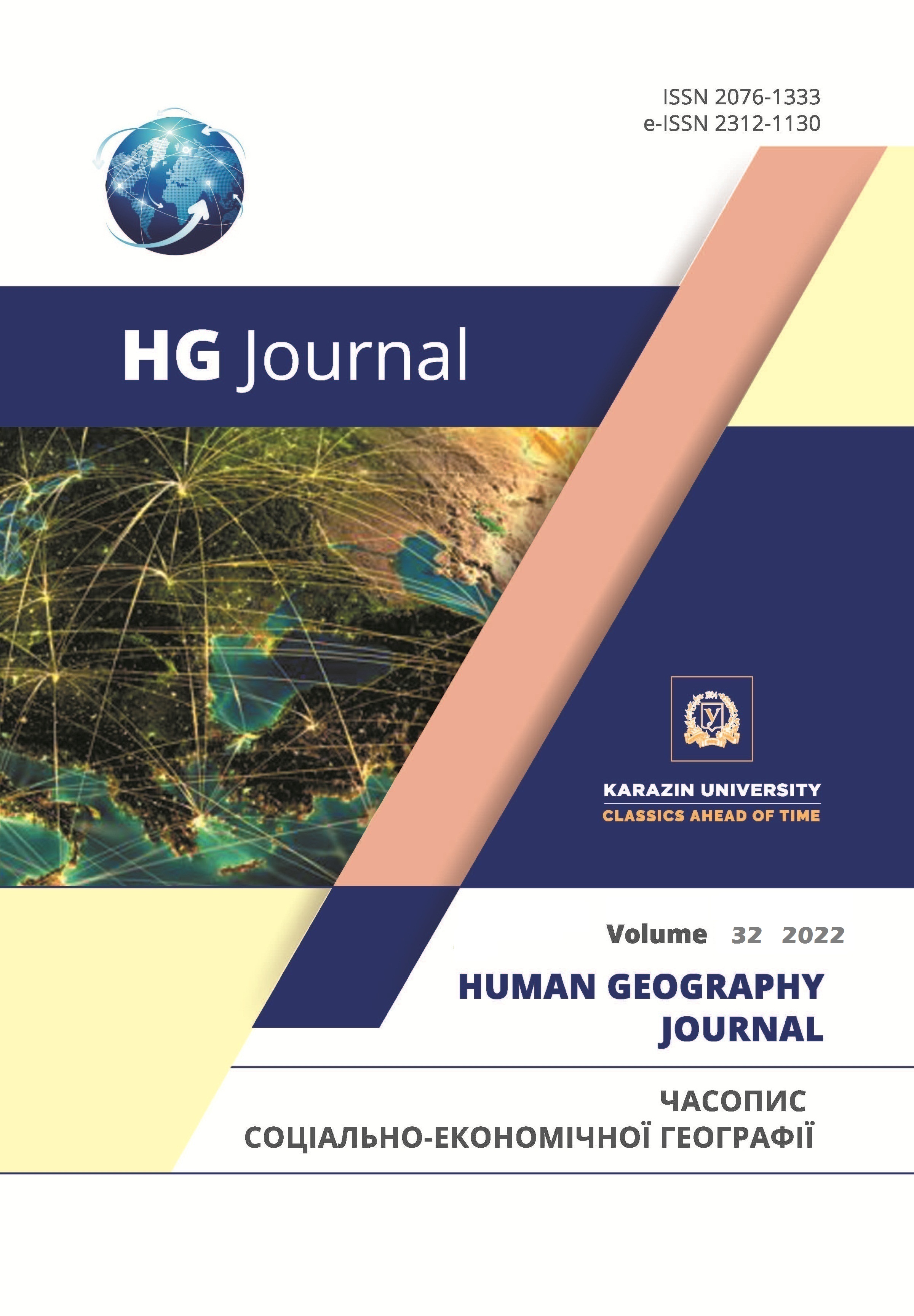Resettlement features of population of Ternopil oblast in the context of new administrative and territorial system
Abstract
The study is devoted to the study of territorial differences in the resettlement of the population of Ternopil oblast after the introduction of changes in the administrative-territorial structure of the oblast, as one of the oblast regions where the boundaries and centers of the new administrative raions practically coincided with their eponymous inter-district resettlement systems. After all, as a result of the change in the administrative-territorial system, we received a certain redistribution of the population within the basic units of resettlement systems, and they are the beginning of those irreversible changes in resettlement systems that we will observe in the coming years. The article calculates and analyzes indicators-characteristics of population placement at the level of territorial communities of the oblast. The author uses the indicators of area of administrative units and their population, population density, the average distance between settlements, the coefficient of urbanization and the share of the urban population, the population concentration index and the degree of development of connections between the centers of territorial communities, as an indicator of the future prospects of cooperation between newly formed administrative centers.
According to all the analyzed characteristics, at the raion level, Ternopil raion takes the leading position, and it was formed on the basis of the inter-district resettlement system of the same name. While Kremenets acts as an outsider. Which is expected, taking into account the peculiarities of the development of the Ternopil subregional resettlement system. But studies at the level of territorial communities, which actually have become the basis of new resettlement systems at the local level, have shown qualitative advantages in the resettlement characteristics of communities that form the supporting framework of resettlement in Ternopil oblast. The obtained results showed that the existing disproportions in the resettlement of the population of the study region, with the implementation of the new administrative-territorial system, have not only remained, but will intensify in the future. As a result of the analysis of all the above-mentioned indicators-characteristics of resettlement, the determining role of centers former inter-raion resettlement systems and separate centers of bush-level resettlement systems can be traced.
Downloads
References
Decentralization provides opportunities. Retrieved from https://decentralization.gov.ua/ [in Ukrainian].
Dzhaman, V. O. (2003). Regional resettlement systems: demogeographical aspects: monograph. Chernivtsi: Ruta, 392 p. [in Ukrainian].
Dotsenko, A. I. (2010). Rural resettlement in Ukraine: dynamics and structure. Kyiv: RVPS of Ukraine, National Academy of Sciences of Ukraine. Phoenix. 288 p. [in Ukrainian].
Zablotovska, N. V., & Levitska, I. V. (2013). Modern features of the formation and development of the Khmelnytskyi inter-raion resettlement system. Scientific Bulletin of Chernivtsi University. Geography, 672/673, 92-94 [in Ukrainian].
Zavarika, H. M., & Zavarika, K. A. (2012). The influence of traditional factors on the transformation of resettlement. Efficient economy, 6, 15-22 [in Ukrainian].
Zastavetska, L. (2013). Principles of formation and mechanisms of functioning of new territorial communities and resettlement systems in the process of reforming. Scientific Bulletin of Chernivtsi University. Geography, 672/673, 95-100 [in Ukrainian].
Zastavetska, L. B. (2013). Territorial organization of resettlement systems: basic patterns and principles. Geography and tourism, 24, 197-204 [in Ukrainian].
Kachailo, M. M., & Vlakh, M. R. (2017). Factors and directions of the transformation of the region’s resettlement system in modern conditions (on the example of Transcarpathian oblast). Scientific notes of Volodymyr Hnatyuk Ternopil National Pedagogical University. Series: Geography, 2, 40-45 [in Ukrainian].
Mezentsev, K. V., & Nelipa, K. G. (2018). Post-Soviet transformations of the resettlement system of the industrial region – the case of the Zaporizhzhia oblast. Scientific Bulletin of Kherson State University. Series: Geographical sciences, 9, 69-78 [in Ukrainian].
Oliynyk, Y. B., & Ostapenko, P. O. (2016). Formation of capable territorial communities in Ukraine: advantages, risks, threats. Ukrainian Geographical Journal, 4, 37-43 [in Ukrainian].
Ostapenko, P. O. (2018). Transformation of the administrative-territorial system of Poltava oblast: socio-geographic research. Candidate’s thesis. Kyiv [in Ukrainian].
Resolutions of the Verkhovna Rada of Ukraine. About the formation and liquidation of raions from 17.07.2020. № 3650. Retrieved from http://w1.c1.rada.gov.ua/pls/zweb2/webproc4_2?id=&pf3516=3650&skl=10 [in Ukrainian].
Order of the Cabinet of Ministers of Ukraine dated June 12, 2020 No. 724 About determining administrative centers and approving the territories of territorial communities of Ternopil oblast. Retrieved from https://www.kmu.gov.ua/npas/pro-viznachennya-administrativnih-a724 [in Ukrainian].
Sehida, K. Yu. (2013). Methodological basis of the analysis of population resettlement in the region. Problems of continuous geographical education and cartography, 18, 150-155 [in Ukrainian].
Statistical yearbook of the Ternopil oblast for 2019. Main Department of Statistics in Ternopil oblast. Retrieved from http://www.te.ukrstat.gov.ua/files/Bul/ks_z1_2019.pdf [in Ukrainian].
Shevchuk, S. M. (2020). Administrative-territorial system of Poltava oblast: retrospective-prospective model. Bulletin of Odesa National University. Geographical and geological sciences, 25(1 (36)), 84-197 [in Ukrainian].
Niemets, K., Kravchenko, K., Mazurova, A., Sehida, K., & Lurie, A. (2018). Regional settlement system as a basis for the formation of growth poles (case of Kharkiv region). Human Geography Journal, 24, 39-46. https://doi.org/10.26565/2076-1333-2018-24-04
Niemets, L., Sehida, K., Kravchenko, K., Telebienieva, I., & Pohrebskyi, T. (2020). Regional settlement systems in Ukraine: features of development in terms of decentralization reform. Human Geography Journal, 29, 6-17. https://doi.org/10.26565/2076-1333-2020-29-01
Copyright (c) 2022 Natalia Zablotovska, Olha Danilova, Mykhailo Salii

This work is licensed under a Creative Commons Attribution 4.0 International License.




